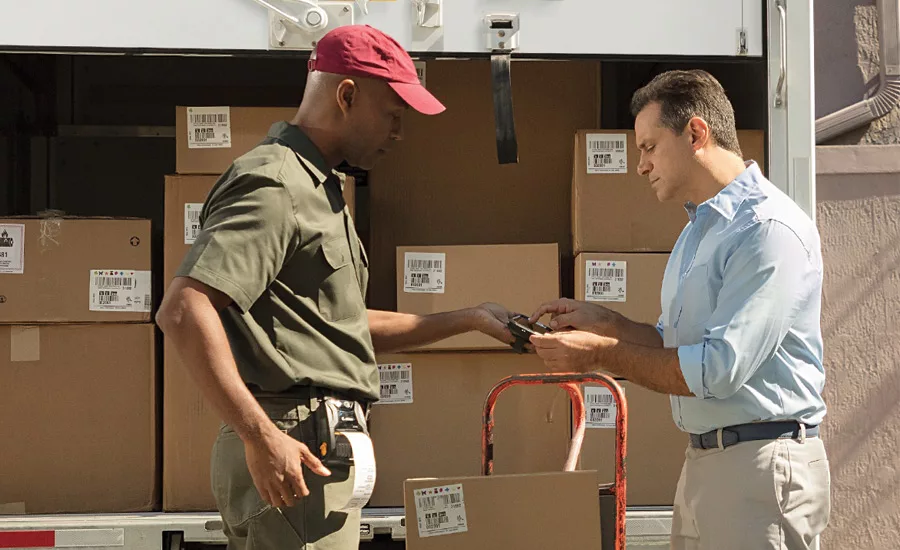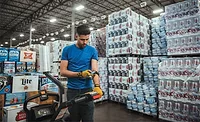Distribution
Direct-store-delivery technology works to meet customer expectations
Retailers seek DSD platforms that track delivery status

With the desire for “instant gratification” prevalent throughout the United States and beyond, eCommerce is giving shoppers exactly what they want. In need of groceries? Submit an order with a grocery delivery service and have them at your door in as little as an hour. Waiting for a package? Check your email for a tracking link that tells you exactly where it is and when it will be delivered. As a result, customer expectations are higher than ever — both for end consumers as well as the retailers that supply them.
Just-in-time delivery is one of the biggest trends in beverage distribution, says Doug Eden, president of IntelliShift, a division of VTS, Commack, N.Y.
“There used to be a 48-hour lead time for filling orders,” he explains. “Now, customers want almost everything instantaneously and want shorter order-to-delivery times. Because many beverage customers supply and sell through Amazon, customers will order small quantities through Amazon, which, in turn, impacts overall revenue.”
Along these lines, shoppers also expect greater product variety in stores, mirroring the variety they’re afforded online.
As a result, distributors are being asked to fit more SKUs into the same amount of space, IntelliShift’s Eden explains.
“This results in less space per item, which, in turn, takes more time and effort for the delivery,” he says. “When there were fewer SKUs to deliver, the delivery could be done with layering pallets. Now deliveries are coming in smaller orders per SKU, and it takes more time to get more items into the same amount of space.”
Therefore, deliveries and routes must be more efficient to offset the extra time it takes to deliver a greater number of SKUs, Eden says.
This is where direct-store-delivery (DSD) solutions come into play.
DSD technology
In order to optimize route delivery, DSD accounts employ hardware and software specifically designed to improve efficiency.
Brother Mobile Solutions, for instance, supplies rugged, wireless mobile printers that are critical to success in route delivery, says Ravi Panjwani, vice president of marketing and product management for the Westminster, Colo.-based company.
“With the increased need for speed and efficiency, we must continuously innovate mobile print technology, hardware design and accessories,” Panjwani says. “Route and warehouse operators demand reliable printer connectivity with all devices — especially with growing iOS adoption. They want printers with dual-radio Wi-Fi and Bluetooth capability, lighter yet more rugged form factors, smart docking and charging solutions, and fast, flexible pairing solutions. Simplicity and reliability are paramount.”
Above all, connectivity at every point along the route is vital, he says. For instance, Brother Mobile Solutions offers its RJ4250WBL mobile printer, which is engineered with dual Wi-Fi/Bluetooth connectivity options to ensure that drivers can print labels anywhere — even in areas with unreliable Wi-Fi such as rural areas and inside warehouses.
Telematics and connected operations data also play a vital role in reducing delivery time, IntelliShift’s Eden notes.
“Telematics and connected operations’ data provide valuable information on how much time is spent at the delivery locations,” he explains. “Without these insights, fleet operators do not have effective visibility into operational effectiveness. They now have a lot of data that can help toward shortening overall delivery times.”
For example, operational intelligence can help companies learn the optimal days and times for deliveries, how long the delivery is in transit, the amount of time a representative spends at an account, and how often representatives should visit customers to follow up on an order, Eden explains. This data can then be used to make efficiency improvements across the supply chain, he says.
In the warehouse, technology is making order filling easier, thereby increasing efficiency as well as reducing worker turnover, says Jake Sampson, vice president of sales and marketing at Encompass Technologies, Fort Collins, Colo.
“Distributors are experiencing labor challenges with high turnover in the warehouse as a result of expanded portfolios and new products,” he explains. “This has created a demand for [warehouse management systems] (WMS), voice pick and even warehouse automation to make fulfilling orders easier and more efficient.”
Voice-directed picking, for instance, enables the worker to use an iOS or Android device that tells them where to go, what to pick and what quantity to pick, so in-depth knowledge of the warehouse and SKUs is not necessary, Sampson explains.
Familiar mobile platforms also are boosting efficiency while reducing turnover, he adds.
“We’ve seen DSD hardware suppliers begin to cater to existing mobile solutions (iPhones, iPads, iPods, Android devices, etc.) because employees are beginning to demand the same type of user experiences at work as they are used to in their personal lives,” Sampson says. “Deploying intuitive mobile solutions definitely helps increase efficiency, as well as reduce turnover rates and increase employee morale.”
For instance, Brother Mobile Solutions offers a line of RuggedJet mobile printers with built-in Apple AirPrint capability and seamless Apple and Android integration, Panjwani notes. This allows route drivers to instantly print from their Apple or Android device without having to download special drivers or interfaces, he explains.
Radio-frequency identification (RFID) also remains a significant trend in the beverage distribution market — especially because RFID has become more affordable and easier to scale, says Paul Hilton, North America field mobility lead for Zebra Technologies, Lincolnshire, Ill.
“More proof of concepts for RFID have begun to emerge as well, such as reusable pallet tracking solutions, as companies recognize the numerous benefits offered by implementing RFID in their warehouses and across the supply chain,” Hilton says.
What retailers want
In addition to maximizing efficiency, retailers are seeking convenience and cost reduction.
In terms of convenience, many retailers are interested in applications that allow them to track a shipment’s estimated time of arrival, IntelliShift’s Eden says.
“In retail, there is only so much room for delivery or in the aisles of the stores to have people filling the shelves,” he explains. “The IntelliShift Customer 360 Scheduling App allows customers to know when the beverages will be in the store so they can plan accordingly.”
Additionally, streamlined ordering platforms like Encompass Technologies’ DSDLink were designed to simplify the ordering process for retailers, Sampson says. Instead of ordering from sales representatives, retailers can place orders from all their distributors at once, at their convenience, he notes. They also have easy access to new products, which can be filtered by type and style; up-to-date pricing; current discounts and promotions; and order status. Distributors also gain valuable time and resources by freeing up their sales representatives to focus on product displays, customer service, etc., promote products via custom ads, and more.
To reduce cost, Brother Mobile Solutions’ Panjwani suggests customers look at Hardware-as-a-Service (HaaS) solutions.
“To successfully compete in today’s ‘always-on’ world requires speed and efficiency,” Panjwani says. “One of the best ways for distributors to ensure peak performance is to take advantage of the most up-to-date software, hardware and devices. However, deploying the most advanced technology can be challenging due to cash flow or competing budgetary priorities.”
Thus, many distributors are turning to HaaS options, such as Brother Mobile Solutions’ new Shift & Print subscription service, he says.
“Instead of paying for technology up front and in a lump sum, distributors will be able to make predictable monthly payments for hardware, consumable supplies, accessories and warranties,” Panjwani explains. “HaaS offers a host of benefits, including increased uptime, built-in scalability and the ability to keep current with the latest and greatest.”
Retailers also can save money by using alternative delivery options, such as routing small orders through Amazon or even picking orders up directly from the distribution center, IntelliShift’s Eden says.
“It’s becoming increasingly cost prohibitive to deliver small orders,” Eden says. “Our customers tell us that our integrated fleet and asset intelligence solutions give them visibility into the right data sets, which helps manufacturers to understand the total cost of delivery and whether or not it might be smarter or more cost-effective for them to route orders through Amazon rather than delivering. The data also gives their customers alternatives on how they want to have their orders filled. Now, manufacturers are letting customers pick up directly from their distribution centers rather than have it delivered, which sometimes is the more costly option.”
Moving forward
More and more often, retailers are moving away from scan-based trading systems to digital receiving systems that are able to connect on-shelf inventory data with online ordering and click-and-collect systems, Zebra Technologies’ Hilton says.
The future of retail is getting increasingly more digitized, as the cloud broadens the capabilities of DSD solutions, Encompass Technologies’ Sampson adds.
“From accessing real-time data anywhere, on any device, to increased security and reliability, the cloud has had huge impacts on the solutions in the market today,” he says.
In the future, the Internet of Things is expected to create even more opportunities for distributors to improve efficiency and strengthen their competitive edge, Brother Mobile Solutions’ Panjwani says.
“From powerful, cloud-connected mobile devices to route management software with predictive analytics capabilities, distributors will increasingly be able to capitalize on new levels of route intelligence such as route optimization, driver behavior, compliance with [electronic logging device] (ELD) mandates, engine diagnostics and more,” he predicts.
Even further into the future, the industry might see self-driving trucks and drones take automation one step further, Encompass Technologies’ Sampson adds.
In the meantime, Zebra Technologies is working on a solution to help reduce accidents caused by distracted delivery drivers in order to improve safety and reduce cost, Hilton explains.
“I think we’ll continue to see more companies look for these types of solutions in order to reduce insurance premiums and improve driver safety on the road,” he says.
Looking for a reprint of this article?
From high-res PDFs to custom plaques, order your copy today!





